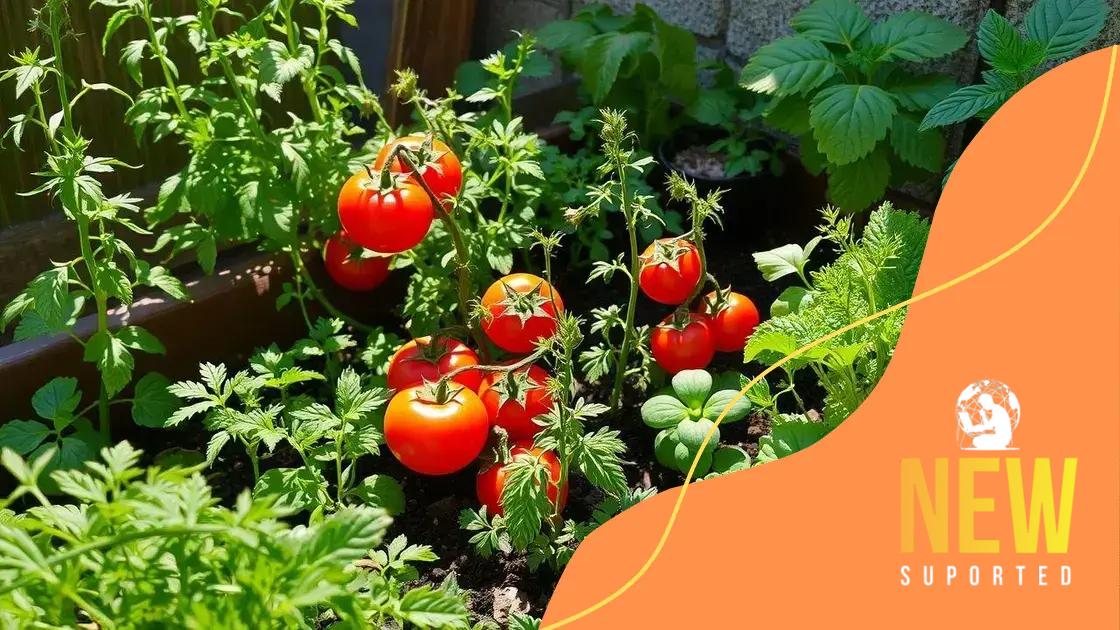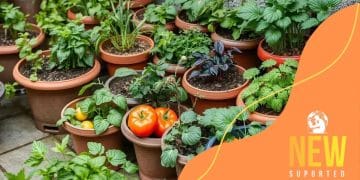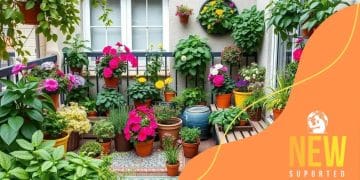How to grow an edible garden on your patio

To grow an edible garden on your patio, choose suitable containers, select plants like herbs and cherry tomatoes, and provide proper care and watering techniques to ensure healthy growth and pest protection.
Have you ever thought about how fulfilling it is to grow your own food? Starting a edible garden on your patio can transform that idea into reality. With a bit of planning and the right plants, you can enjoy fresh produce right from your home.
Choosing the right containers for your patio garden
Choosing the right containers for your patio garden is crucial for success. The right containers not only enhance the appearance of your garden, but they also provide the necessary environment for your plants to thrive. You can opt for various materials, shapes, and sizes depending on your space and preferences.
Types of Containers
There are several types of containers that work well for edible gardens on patios, such as:
- Plastic pots: Lightweight and often less expensive, these pots come in various colors and sizes.
- Clay pots: These provide good drainage and are aesthetically pleasing but can be heavy.
- Raised beds: Ideal for larger spaces, they offer greater soil depth and planting options.
- Window boxes: Perfect for herbs and small vegetables, these can be placed on railings or ledges.
Each container type has its benefits, so it’s essential to consider what will work best for your specific needs.
Size Matters
The size of your container affects the growth and health of your plants. Generally, larger containers have better soil capacity, leading to healthier roots. For instance, a pot that is at least 12 inches in diameter is suitable for many vegetables like tomatoes and peppers. On the other hand, smaller pots are excellent for herbs or trailing plants that won’t need as much room to spread.
When selecting containers, also keep in mind the drainage options. Ensuring that each container has sufficient drainage holes is vital to avoid root rot. You can also consider adding a layer of gravel or stones at the bottom of your containers for improved drainage.
Incorporating creativity is equally important. Brightly colored pots can liven up a dull patio while blending in with your home’s decor. Think about grouping your containers in a way that makes them visually appealing while also providing the right amount of sunlight for each plant.
Finally, always consider the ease of mobility. If your patio receives varying amounts of sunlight throughout the day, you may want to choose light containers that you can easily move around to find the ideal conditions for your plants.
Selecting the best edible plants for small spaces
When it comes to selecting the best edible plants for small spaces, you’ll find many options that thrive in containers. The key is to choose plants that are suitable for limited areas while providing a hearty yield. It’s exciting to think that even if you have just a small balcony or patio, you can grow fresh food right at home.
Top Edible Plants for Small Spaces
Here are some of the best options:
- Herbs: Basil, mint, and cilantro are great choices. They grow well in smaller pots and can be used in many recipes.
- Lettuce: Leafy greens like romaine and butterhead can be harvested frequently, giving you a continuous supply.
- Cherry tomatoes: These not only produce a bountiful harvest but also add vibrant color to your patio garden.
- Radishes: Fast-growing and compact, they can be ready to harvest within a month.
Each of these plants can adapt to container gardening, making them ideal for your limited space.
In addition to the plants mentioned above, consider picking dwarf or bush varieties of vegetables. For instance, bush beans and dwarf peppers take up less room while still offering a productive harvest. Think creatively about vertical gardening; using wall planters or tiered shelves can maximize your space significantly.
It’s essential to ensure that your chosen plants receive the right amount of sunlight. Most edible plants thrive in at least six hours of direct sunlight daily. Therefore, when deciding where to place your containers, consider both sunlight needs and your living space’s layout.
Finally, remember to rotate your plants. Mixing in different varieties in a single container can not only save space but also deter pests. For example, growing marigolds alongside vegetables helps protect against aphids.
Soil and care tips for a thriving garden

Having the right soil and care is essential for creating a thriving garden in your small patio. Healthy plants begin with quality soil, which provides them with nutrients and support. The best soil for container gardens is rich in organic matter and drains well.
Choosing the Right Soil
Look for a high-quality potting mix that contains:
- Organic compost: It enriches the soil with nutrients that promote growth.
- Pearlite or vermiculite: These components improve aeration and drainage, preventing waterlogging.
- Coconut coir: This helps retain moisture without compacting the soil, which is crucial for container gardening.
Always avoid using garden soil in containers, as it can become compacted and limit root growth.
Watering Techniques
Watering is another critical aspect of plant care. Container plants often dry out faster than those in the ground, so it’s important to check the moisture levels regularly. A good rule of thumb is to water when the top inch of soil feels dry. Be sure to water deeply so that moisture reaches the roots.
Additionally, consider using self-watering pots if you find it challenging to maintain consistent moisture. They allow your plants to absorb water at their own pace, promoting healthy growth.
Another tip is to use mulch to help retain moisture in your pots. A layer of mulch on top of the soil can reduce evaporation and keep the roots cool. Just be careful not to cover the plant stems as this can lead to rot.
Lastly, don’t forget about fertilizing your plants. Since container plants rely entirely on the nutrients in their soil, using a balanced, slow-release fertilizer every few months is vital for their health. Organic options, such as fish emulsion or seaweed extract, are excellent choices that nourish the plants without harsh chemicals.
Watering techniques to ensure healthy growth
Watering techniques play a crucial role in ensuring healthy growth for your patio garden. Proper watering not only helps plants thrive but also prevents common issues like root rot and fungal diseases. Understanding how and when to water your plants is key to successful gardening in small spaces.
Watering Frequency
In general, container plants require more frequent watering than those in the ground. Factors like the size of the pot, type of plants, and environmental conditions affect watering needs. A good practice is to check the soil moisture every few days. When the top inch feels dry, it’s time to water.
- Morning waterings: Watering early in the day allows plants to absorb moisture before the heat of the sun.
- Evening waterings: If morning isn’t possible, watering in the evening is a good alternative, but avoid overhead watering to prevent disease.
- Seasonal adjustments: During hot summer months, you may need to water more frequently than in cooler seasons.
Using these strategies helps maintain consistent moisture levels.
How to Water Correctly
Using the right method is just as important as the timing. Techniques like the following can make a big difference:
- Deep watering: Water thoroughly until it drains from the bottom. This encourages roots to grow deeper.
- Avoid overwatering: Too much water can suffocate roots and lead to rot. Ensure containers have drainage holes.
- Using a drip system: Consider drip irrigation for constant moisture without the hassle of manual watering.
Observe your plants for signs of underwatering or overwatering, like drooping leaves or yellowing foliage, and adjust your watering practices accordingly.
Lastly, make sure to use water that is at room temperature. Cold water can shock the plants’ roots, while lukewarm water helps maintain soil temperatures and promotes absorption.
Common pests and how to protect your garden
Common pests can threaten your patio garden, but knowing how to identify and protect your plants can make all the difference. Keeping an eye on your crops will help you catch problems early and enjoy a healthy garden.
Identifying Common Pests
Recognizing pests is the first step to controlling them. Some usual culprits include:
- Aphids: Small and often green, these pests suck the sap from plants and can lead to wilting.
- Spider mites: Tiny and usually found on the underside of leaves, they can cause yellowing and eventually leaf drop.
- Whiteflies: These small, white insects fly up when disturbed and feed on the plant’s juices.
- Slugs and snails: These slithering pests create holes in leaves and thrive in moist environments.
Identifying these pests early can help you take swift action to protect your plants.
Natural Ways to Protect Your Garden
There are several ways to manage pests without resorting to harsh chemicals. Here are some effective methods:
- Companion planting: Certain plants can repel pests. For instance, planting marigolds can deter nematodes and aphids.
- Neem oil: This natural pesticide is effective against many pests and safe for your plants. Mix it with water and spray on affected areas.
- Row covers: Lightweight fabric can protect plants from insects while allowing sunlight and moisture to penetrate.
These methods are gentle on the environment and help keep your garden healthy.
Additionally, keeping your garden clean and free of debris can reduce places where pests like to hide. Regularly inspect your plants for signs of damage and take action as soon as you notice a problem. Setting up traps for pests such as slugs or using sticky traps for flying insects can also be beneficial.
Don’t forget to encourage beneficial insects like ladybugs and lacewings, which help control harmful pest populations naturally. Creating a balanced ecosystem in your patio garden can lead to greater success in growing healthy plants.
In summary, creating a successful edible garden on your patio is both rewarding and achievable. By selecting the right containers, choosing suitable plants, and providing proper care, you can enjoy fresh produce right at home. Be mindful of common pests and implement easy solutions to protect your garden. With a bit of effort and creativity, your patio can transform into a beautiful and productive space.
FAQ – Frequently Asked Questions about Growing an Edible Garden on Your Patio
What types of plants are best for a small patio garden?
Herbs like basil and cilantro, as well as vegetables such as cherry tomatoes and leafy greens like lettuce, are excellent choices for small spaces.
How often should I water my patio garden?
Container plants typically need to be watered more frequently than ground plants. Check the soil moisture every few days and water when the top inch feels dry.
What can I do to protect my garden from pests?
Use natural methods, like companion planting, neem oil, and row covers, to deter pests without harmful chemicals.
How can I ensure my plants get enough nutrients?
Start with a quality potting mix and add slow-release fertilizers every few months to provide ongoing nutrients for your container plants.






